For ultimate privacy barriers, consider Green Giant Arborvitae (reaching 50-60 feet) or Leyland Cypress (growing 3-4 feet annually). Other excellent options include Privet Hedges (10-15 feet), Cherry Laurel (10-15 feet), and various Holly varieties (up to 30 feet). Plant these shrubs 5-8 feet apart for ideal density and maintain with regular watering and annual pruning. Your landscape’s privacy potential expands dramatically with these towering, low-maintenance solutions.
Towering Arborvitae: The Perfect Living Barrier
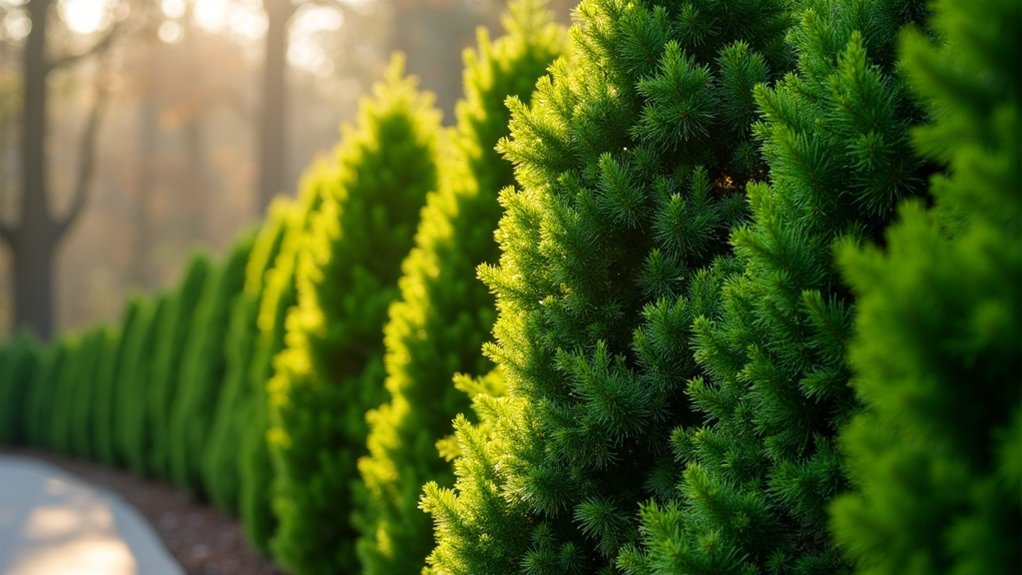
When privacy becomes a priority for your outdoor space, Towering Arborvitae stands as nature’s perfect solution. The Green Giant variety reaches impressive heights of 50-60 feet with widths of 12-20 feet, creating an impenetrable tall living privacy barrier without consuming excessive yard space.
This fast-growing evergreen thrives in USDA Hardiness Zones 5a-8b and requires minimal maintenance once established. You’ll appreciate its drought tolerance, reducing the need for constant watering while still maintaining its lush appearance.
The dense foliage not only blocks unwanted views but also buffers noise and wind, transforming your garden into a peaceful sanctuary.
Your living wall does double duty—creating visual privacy while silencing the outside world’s distractions.
With its columnar form and year-round greenery, Arborvitae delivers both practical privacy and aesthetic appeal in one magnificent package.
Majestic Leyland Cypress for Quick Privacy Solutions
You’ll be impressed by the Leyland Cypress’s remarkable growth rate of 3-4 feet annually, making it one of the fastest privacy solutions available in zones 6-10.
Despite its rapid growth, this evergreen offers moderate disease resistance when properly spaced, though it’s worth noting that tighter spacing creates denser barriers while wider placement allows for better air circulation.
For ideal screening, consider planting these majestic trees 6-8 feet apart in a staggered pattern to maximize their natural columnar shape while minimizing potential disease issues.
Growth Rate Analysis
Among the fastest-growing privacy options available, Leyland Cypress stands out as nature’s solution to urgent screening needs.
You’ll witness this evergreen shrub growing an impressive 3-5 feet annually under ideal conditions, transforming your exposed yard into a secluded retreat faster than most alternatives.
Within just 10-15 years, your Leyland Cypress can reach mature heights of up to 60 feet, creating a dense privacy screen that effectively blocks unwanted views and reduces neighborhood noise.
For best results, plant these fast growers in full sun with well-drained soil in USDA zones 6-10.
While they’ll need consistent watering when first established, they become relatively drought-tolerant once their root systems develop.
This combination of rapid growth rate and minimal maintenance makes Leyland Cypress an exceptional choice for homeowners seeking quick privacy solutions.
Disease Resistance Benefits
Despite its rapid growth rate, Leyland Cypress offers remarkable disease resistance that makes it a standout choice for long-lasting privacy barriers. You’ll appreciate how this evergreen powerhouse naturally fends off common issues like root rot and blight, ensuring your privacy screening solution remains healthy and vibrant year after year.
Once established in your landscape, Leyland Cypress requires minimal maintenance while continuing to provide dense, lush foliage regardless of soil conditions. This adaptability across USDA Hardiness Zones 6 to 10 means you can count on consistent performance in various climates.
The natural disease resistance complements its impressive height potential of 60+ feet and conical shape, creating an effective noise buffer and visual barrier that enhances your outdoor space’s beauty and functionality.
Alternative Spacing Options
While traditional planting guidelines recommend 8-foot spacing, Leyland Cypress offers remarkable flexibility that can be tailored to your specific privacy needs.
For ultra-dense barriers, you can plant these fast-growing shrubs as close as 5 feet apart, creating an impenetrable screen in record time.
If you’re seeking a more natural, less formal look, consider wider 10-foot spacing that still delivers privacy while allowing each tree to showcase its elegant form.
In full sun locations, these adaptable evergreens will thrive regardless of spacing, reaching heights up to 60 feet while growing an impressive 3 feet annually.
For properties with limited space, you might opt for a single-row configuration, while larger areas benefit from staggered, double-row arrangements that maximize privacy while maintaining healthy airflow between plants.
Versatile Privet Hedges for Dense Screening
Privet hedges offer several outstanding varieties including the common Ligustrum vulgare and glossy California privet, each providing unique density and height capabilities for your privacy needs.
You’ll achieve the fastest growth—up to 2 feet annually—by implementing strategic pruning techniques that focus on removing one-third of the oldest stems each spring while maintaining a wider base than top.
Your seasonal maintenance should follow a simple calendar: spring fertilization and structural pruning, summer shape trimming, fall cleanup, and winter protection in colder zones to guarantee your privet hedge remains dense and healthy year-round.
Privet Varieties Comparison
When seeking a fast-growing solution for privacy concerns, few shrubs match the versatility of privet hedges for creating dense, customizable screens.
Privet (Ligustrum) varieties can provide privacy remarkably quickly, with most species growing about 2 feet annually until reaching their mature height of 10 to 15 feet.
You’ll find privets thriving across USDA zones 4a to 10b, making them adaptable to various climate conditions.
As a fast grower that requires minimal care once established, privet hedges offer practical benefits for busy homeowners. Their drought tolerance and adaptability to different sun exposures (full to partial) make them even more appealing.
While all varieties feature dense foliage that responds well to pruning, remember that privet produces toxic fruits and leaves—an important consideration if you have pets or children.
Fast-Growth Pruning Techniques
To maximize the impressive two-foot annual growth rate of your privet hedge, strategic pruning techniques are vital. Timing your cuts during late spring or early summer after flowering encourages vigorous new growth while maintaining your privacy hedge’s dense structure.
You’ll achieve peak screening when you trim the top slightly more than the sides, promoting upward development and a thick appearance.
- Prune regularly to stimulate bushier growth, transforming your fast-growth privet into an impenetrable privacy barrier between 6-15 feet tall.
- Don’t fear aggressive cutting—privet tolerates heavy pruning, allowing for complete rejuvenation if your hedge becomes overgrown.
- Shape with intention by tapering slightly inward at the top to guarantee sunlight reaches the lower branches, maintaining fullness from top to bottom.
Seasonal Maintenance Calendar
Throughout the year, your privet hedge requires specific care to maintain its impressive screening capabilities and robust health. These flowering shrubs grow about 2 feet annually, making seasonal maintenance essential for their dense screening potential.
| Season | Privet Hedge Maintenance |
|---|---|
| Winter | Perform major pruning in late winter to encourage dense spring growth |
| Spring | Apply balanced fertilizer; trim after flowering period ends |
| Summer | Water during dry spells; maintain shape with light pruning |
| Fall | Reduce watering as growth slows; prepare for winter dormancy |
| Year-round | Monitor for pests and diseases; maintain 2-3″ mulch layer |
For new plantings, you’ll need more frequent watering during the first few months. Once established, these versatile privacy screens require less attention while still providing that rapid growth you’re looking for.
Cherry Laurel: Elegant and Effective Boundary Shrubs
Sophistication and functionality blend seamlessly in the Cherry Laurel (Prunus laurocerasus), a fast-growing evergreen that reaches impressive heights of 10-15 feet.
This versatile privacy barrier thrives in USDA zones 5b-9b, adapting effortlessly to both full sun and partial shade conditions.
- The Schip Laurel cultivar’s distinctive goblet shape creates an aesthetically pleasing natural screen.
- Once established, you’ll appreciate its drought tolerance and minimal maintenance requirements.
- Glossy leaves provide year-round dense coverage while responding well to pruning for customized shapes.
You’ll find Cherry Laurel particularly valuable as an evergreen shrub that combines practical screening with elegant landscaping appeal.
Its lush foliage maintains privacy throughout all seasons, making it an ideal choice when you’re seeking both beauty and functionality in your outdoor boundaries.
Evergreen Holly Varieties for Year-Round Seclusion

When privacy remains a top priority across all seasons, evergreen holly varieties deliver exceptional performance with their dense, year-round foliage and impressive heights.
Unlike deciduous alternatives, American Holly stands tall at 30 feet, providing privacy without seasonal gaps.
For narrow spaces, consider Emerald Colonnade Holly, reaching 12 feet with an upright habit that won’t overwhelm your landscape.
Japanese Holly offers versatility with heights from 2-10 feet, perfect for low-maintenance barriers of various sizes.
If you’re facing space constraints but need vertical coverage, Yaupon Holly ‘Scarlet’s Peak’ grows to 20 feet while maintaining a slim 3-foot width.
Most hollies thrive across hardiness zones 5-9, making them adaptable privacy solutions for diverse climates while maintaining their protective greenery throughout the year.
Vibrant Red Twig Dogwood for Seasonal Privacy
While evergreen hollies maintain their screening effect year-round, Red Twig Dogwood offers a different approach to privacy with spectacular seasonal flair. Growing up to 9 feet tall with a rapid growth rate of 2 feet annually, this deciduous shrub creates effective privacy barriers during growing seasons.
You’ll appreciate these distinctive features:
- Striking red stems provide winter interest when other shrubs appear dormant
- White flowers change to berries, attracting birds and wildlife to your garden
- Adaptable to USDA zones 2a-7b, thriving in both full sun and partial shade
Though semi-drought tolerant, your vibrant red twig dogwood will perform best in rich, moist soil.
Consider planting these colorful shrubs for seasonal privacy that transforms beautifully through the year while supporting local wildlife.
Common Ninebark: Hardy Privacy With Visual Appeal
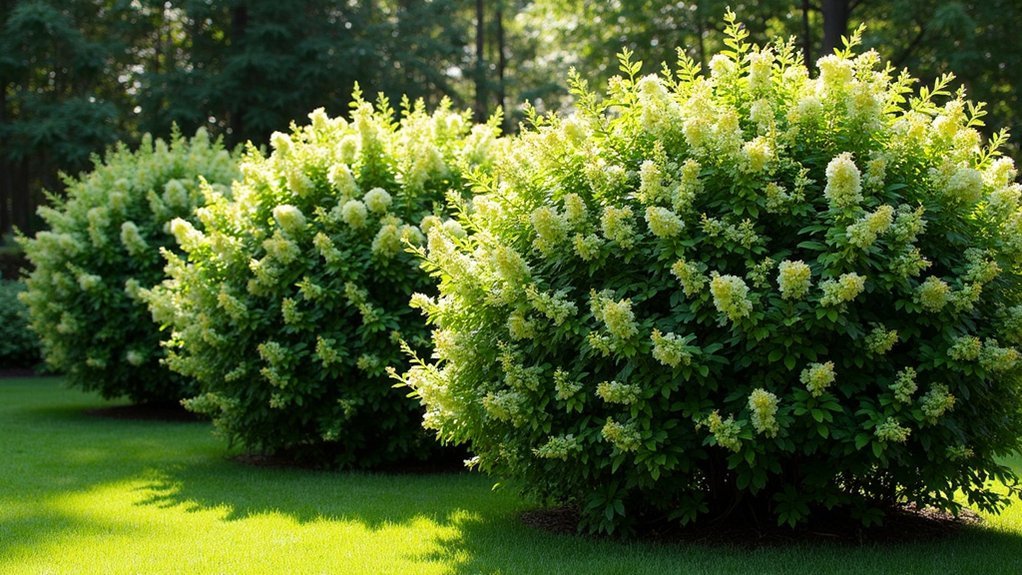
You’ll find Common Ninebark offers year-round visual appeal with its intriguing peeling bark and spring clusters of pink or white flowers that attract pollinators.
This versatile privacy champion grows an impressive 5-10 feet tall and wide, creating an effective natural screen in your landscape.
Its remarkable adaptability to various soil conditions and resistance to deer and drought make it an exceptionally hardy, low-maintenance choice for your garden barriers.
Ninebark’s Multi-Season Interest
Common Ninebark stands out as a privacy barrier that offers year-round visual appeal rather than just seasonal screening. This versatile shrub transforms your landscape throughout the year, changing its appearance while maintaining excellent privacy coverage with its substantial 5-10 foot height and 6-10 foot spread.
- Spring showcase: Clusters of delicate pink or white flowers attract beneficial pollinators to your garden while creating a stunning floral display.
- Summer to fall foliage: Depending on variety, enjoy rich burgundy, vibrant lemon, or classic green leaves that maintain visual interest long after blooming ends.
- Winter structure: Even after leaves drop, the architectural form and exfoliating bark (where ninebark gets its name) provide textural interest against winter landscapes.
Best of all, deer tend to avoid this hardy shrub, ensuring your privacy barrier remains intact regardless of wildlife pressure.
Versatile Hardiness Champion
Few shrubs match the remarkable adaptability of Ninebark when it comes to surviving extreme conditions. This versatile shrub thrives across USDA zones 2a-8b, handling both frigid northern winters and warm southern summers with equal resilience.
You’ll appreciate Ninebark’s substantial presence in your landscape, with its 5-10 foot height and 6-10 foot spread making it ideal for privacy hedges. The arching form creates a natural screening effect while offering visual diversity through its variable spring foliage in green, lemon, or burgundy hues.
Beyond privacy, Ninebark works hard in your garden ecosystem. Its delicate pink or white blooms attract pollinators, supporting local biodiversity.
Even better, deer typically avoid this hardy shrub, ensuring your living barrier remains intact and beautiful throughout the seasons.
Strategic Placement Techniques for Maximum Screening
When creating an effective privacy barrier, the strategic positioning of tall shrubs can dramatically enhance your screening results. Position varieties like Arborvitae or Yaupon Holly at property corners to establish a living wall that blocks sight lines from multiple angles.
For maximum density, plant fast-growing tall shrubs like Privet in staggered rows rather than straight lines.
- Space plants 3-5 feet apart to balance growth needs with creating a living screen that remains healthy.
- Combine evergreen trees like Japanese Blueberry with deciduous varieties for year-round coverage with seasonal interest.
- Consider mature dimensions when selecting placement—remember that some varieties can reach 40-60 feet tall.
This thoughtful arrangement guarantees your privacy barrier remains effective without suffocating the plants, giving you both protection and beauty in your outdoor sanctuary.
Fast-Growing Hydrangea Options for Natural Boundaries
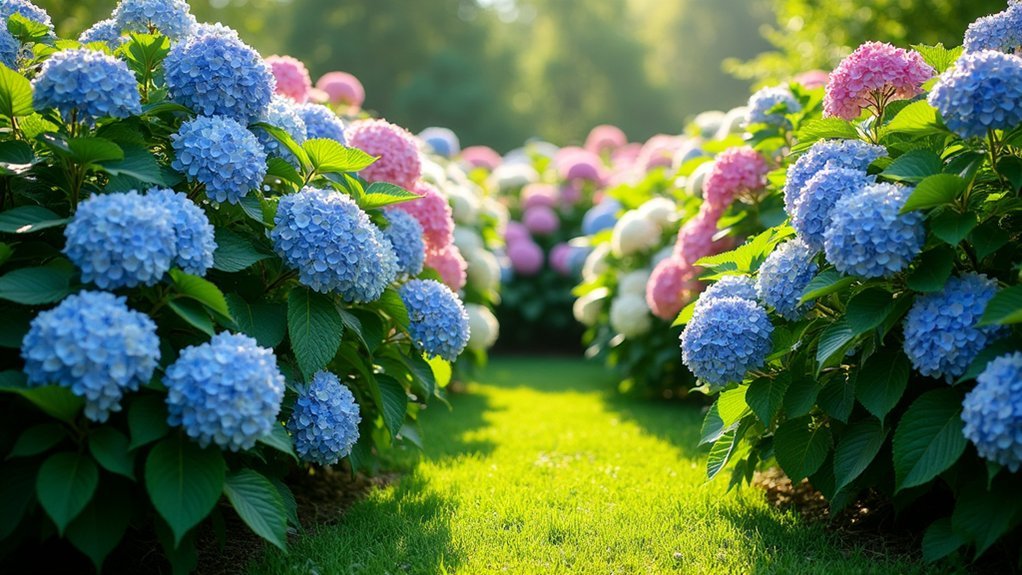
Beyond strategic placement, selecting the right plant varieties can dramatically accelerate your privacy screen development.
Panicle Hydrangeas stand out as exceptional choices, reaching impressive heights of 6-8 feet while creating a lush privacy barrier with their dense foliage and showy blooms.
Towering 6-8 feet, Panicle Hydrangeas offer both privacy and beauty with their dense foliage and dramatic blooms.
These fast-growing shrubs add 2-3 feet annually, quickly establishing natural boundaries in your landscape. You’ll appreciate their adaptability across USDA Hardiness Zones 3-9, making them suitable for various climates.
Plant your hydrangeas in well-drained soil with exposure to full sun to part shade for ideal growth. Not only will they provide the screening you desire, but their long-lasting flowers will also attract beneficial pollinators, enhancing your garden’s biodiversity while maintaining your privacy.
Canadian Hemlock: Shade-Tolerant Privacy Solution
For homeowners seeking privacy solutions in shaded areas, Canadian Hemlock (Tsuga canadensis) offers an exceptional alternative to sun-loving options. This versatile evergreen thrives in USDA Hardiness Zones 3a-7b, reaching impressive heights of 40-70 feet to create an effective privacy barrier.
- Adapts beautifully to part sun or part shade conditions, making it perfect for problematic areas where other privacy plants struggle.
- Features dense, graceful foliage with weeping branches that create an aesthetically pleasing natural screen.
- Tolerates various soil types as long as they provide good drainage.
You’ll need to guarantee consistent moisture, especially during the establishment phase.
With proper care, your Canadian Hemlock will develop into a magnificent shade-tolerant privacy screen that enhances your landscape while providing the seclusion you desire.
Maintenance Strategies for Long-Lasting Living Barriers
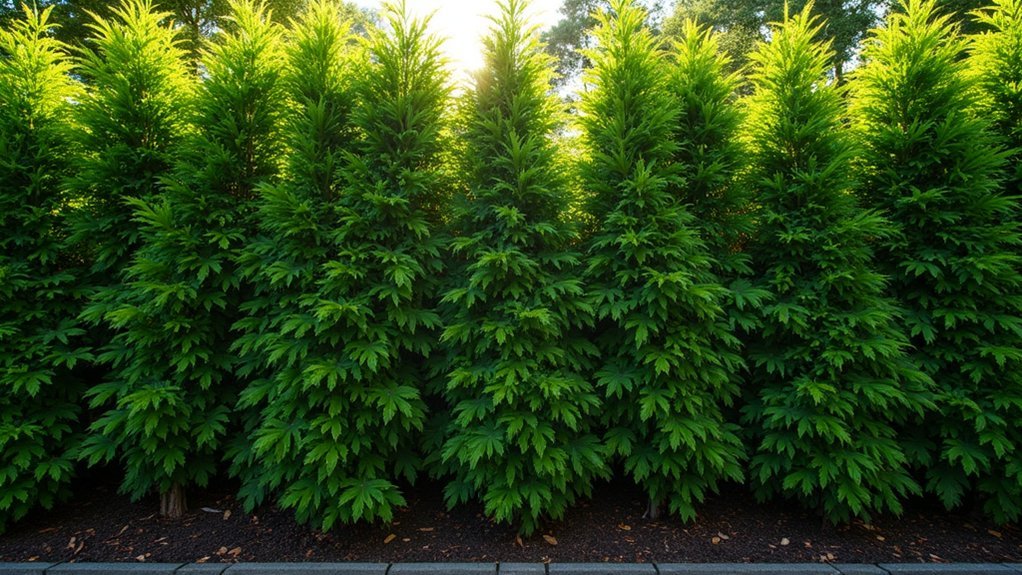
Creating a beautiful privacy barrier is only the beginning of your journey, as proper maintenance guarantees your living screen remains healthy and effective for years to come.
Establish a regular watering schedule, providing weekly irrigation for new plantings until their root systems develop, then adjust based on species needs and local climate.
Don’t neglect annual pruning to maintain shape, promote healthy growth, and prevent disease-encouraging overcrowding.
Apply a balanced slow-release fertilizer in early spring to support vigorous growth and abundant flowering.
Feed your privacy screen’s spring awakening with balanced slow-release nutrients for spectacular growth and blossoms.
Mulching around shrub bases offers multiple benefits: moisture retention, weed suppression, and temperature regulation.
This simple step dramatically reduces maintenance while improving plant health.
Finally, regularly inspect your living barrier for pest and disease issues—early detection allows for prompt intervention, ensuring your privacy screen remains lush and effective for decades.
Combining Shrubs for Layered Privacy Effects
While proper maintenance guarantees your privacy barrier thrives, thoughtful plant combinations elevate it from functional to spectacular.
Creating a layered effect with tall shrubs of varying heights, like 40-60 ft Japanese Blueberry paired with 20 ft Viburnum, adds visual depth while maximizing screening power.
- Mix fast-growing species (Emerald Green Arborvitae) with slower-growing varieties (Boxwood) for immediate privacy while developing long-term structure.
- Blend evergreen shrubs like Yaupon Holly with flowering varieties such as Forsythia for year-round coverage with seasonal interest.
- Incorporate diverse foliage textures and colors, combining glossy Elaeagnus with the vibrant fall hues of Japanese Blueberry.
Your layered privacy screen benefits from selecting plants with complementary light requirements—position shade-tolerant Yew behind sun-loving Privet for a thriving, multi-dimensional barrier that works in various garden conditions.
Climate Considerations for Selecting the Ideal Privacy Hedge
Selecting the perfect privacy hedge requires careful assessment of your local climate conditions, as shrubs that thrive in Vermont will struggle in Texas.
Begin by identifying your USDA Hardiness Zone (2a-10b) to narrow your options to species adapted to your region’s temperature extremes.
Your growing zone is the first filter for privacy hedge selection—it’s the blueprint for smart planting decisions.
For areas with limited rainfall, drought-tolerant varieties like Juniper and Elaeagnus offer sustainable screening without excessive watering.
If you’re seeking rapid coverage, fast-growing options such as Arborvitae and Privet work well in regions with extended growing seasons.
Don’t overlook your soil conditions when making selections.
High-humidity environments benefit from moisture-loving shrubs like Viburnum, while evergreen varieties including Yew and Boxwood provide year-round privacy in colder climates where winter protection is valuable.
Frequently Asked Questions
What Is the Best Bush to Block Neighbors?
You’ll find Arborvitae most effective for blocking neighbors. It grows quickly to 50-60 feet with dense foliage. For tight spaces, consider Yaupon Holly ‘Scarlet’s Peak,’ which reaches 20 feet with a narrow profile.
What Is the Best Plant to Block Neighbours?
For blocking neighbors, you’ll find Arborvitae Green Giant most effective as it grows 50-60 feet tall with dense foliage. Leyland Cypress and Japanese Blueberry are excellent alternatives if you need quick, substantial screening.
What Is the Fastest Growing Plant for Privacy Screen?
You’ll find bamboo grows fastest for privacy screens, reaching up to 3 feet weekly in ideal conditions. Arborvitae Green Giant (3-5 feet yearly) and Privet (2-3 feet yearly) are excellent alternatives that provide dense coverage.
What Shrub Grows Tall and Fast?
You’ll find Arborvitae incredibly fast, reaching 50-60 feet tall for privacy. Privet grows 2 feet yearly to 15 feet, while Cherry Laurel adds 3 feet annually. Japanese Blueberry can reach impressive heights of 40-60 feet.
In Summary
You’ve discovered the ultimate tall shrubs for creating natural privacy around your property. Whether you’re seeking fast-growing options like Leyland Cypress or shade-tolerant varieties like Canadian Hemlock, you’ll find the perfect solution for your climate and needs. With proper maintenance, these living barriers will provide years of beautiful seclusion. Choose wisely, and you’ll enjoy both privacy and enhanced landscape appeal for decades to come.

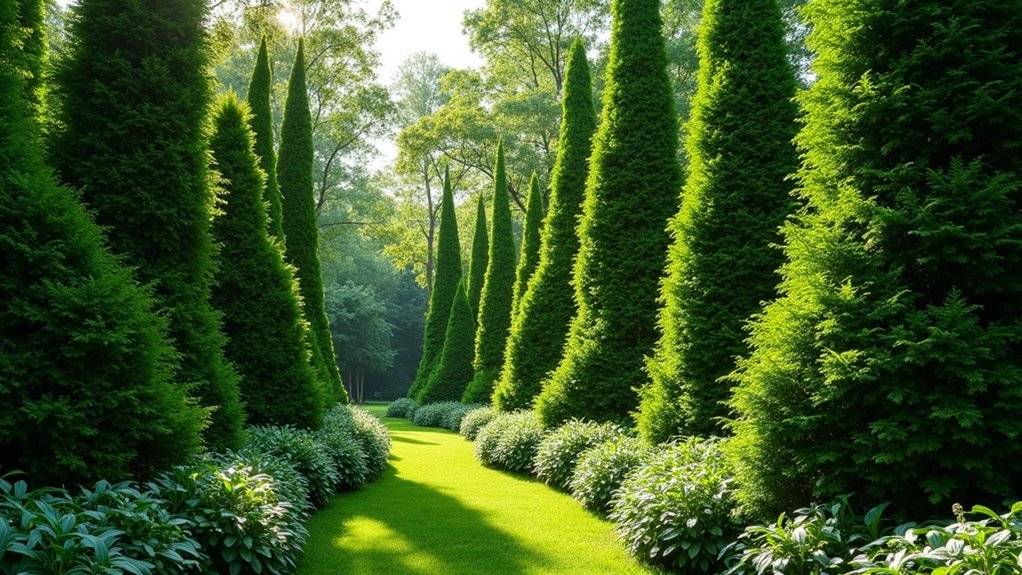

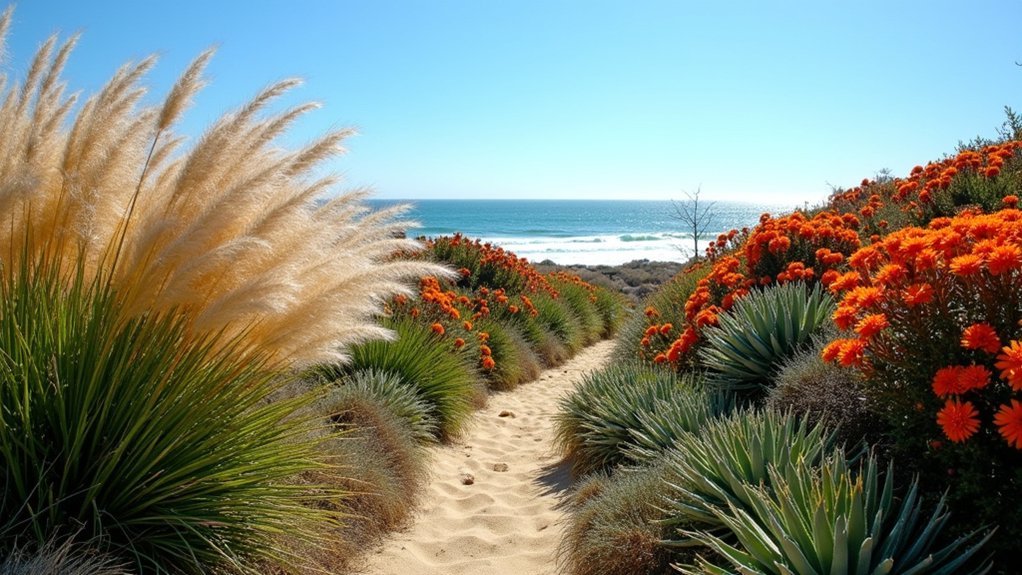
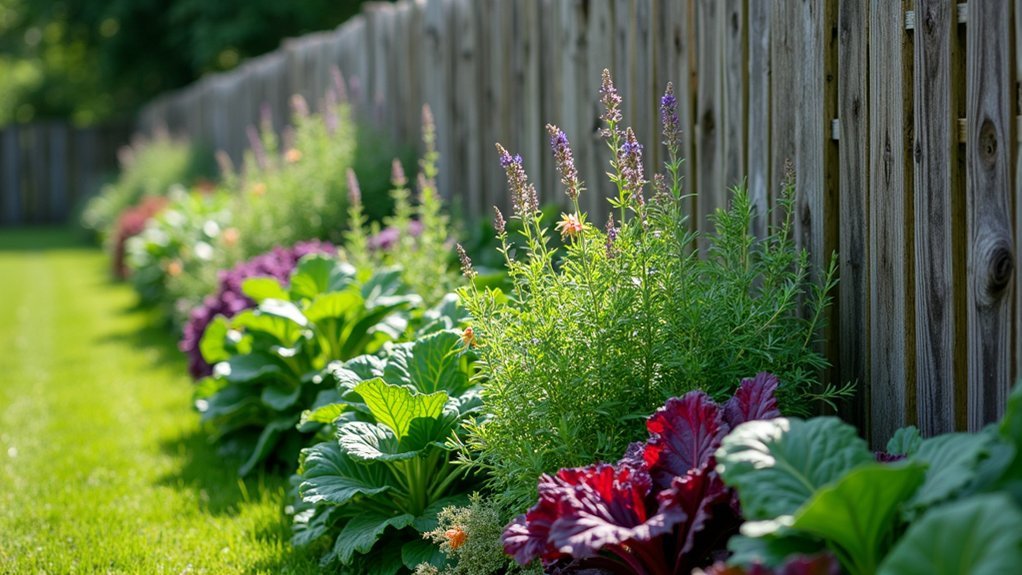
Leave a Reply